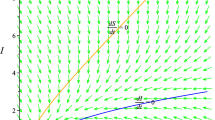Summary
The content of anatoxin was examined at the site of its injection (the muscle) and in the blood serum in one to five days after intramuscular and intravenous immunization. Temporary storage of a certain part of the antigen was noted in the muscle within one to three days. This antigen could be demonstrated in the blood for a period of three to five days. Its intramuscular injection during that period had no promoting effect on the increase of the antigenic concentration in the blood. Therefore, it is assumed that the higher efficacy of the intramuscular method of immunization (as compared with the intravenous) is connected with its action on the regional lymphatic apparatus and not with the more prolonged circulation of the antigen in the blood.
Similar content being viewed by others
Literature Cited
I. B. Volgin, The Significance of the Principle of “Depot” and of Various Methods of Antigen Administration for Active Immunization Against Tetanus, In Russian. Thesis (Moscow, 1955).
S.I. ginzburg-Kalinina, in the book: Transactions of the Mechnikov Scientific-Research Institute of Vaccines and Sera In Russian. Vol. 8 (Moscow, 1956), pp. 160–170.
P.F. Zdrodovskii, The Problem of Reactivity in Study of Infection and Immunity In Russian. (Moscow, 1950).
R.I. Zel'manovich and D.F. Pletsityi, Zhur. Mikrobiol., Epidemiol i Immunobiol. No. 1, 69–71 (1953).
V.I. Ivanov, M.M. Priselkov, S.I. Cherniakhover and S.V. Lesniak, Zhur. Mikrobiol. Epidemiol. i Immunobiol. No. 11, 71–75 (1954).
O.Ia. Ostryi and L.N. Fontalin, Zhur. Mikrobiol., Epidemiol. i Immunobiol. No. 1, 43–49 (1956).
V. Umbreit, R.H. Burris and J.F. Strauffer, Manometric Methods in Studies of Tissue Metabolism [Russian translation] (Moscow, 1951).
E.N. Fontalin, Biull. Eksptl. Biol. i Med. 44, No. 10, 100–105 (1957). Original Russian pagination. See C.B. translation.
P.E. Christensen, Acta path. microbiol. Scandinav. 31, 262–274 (1952).
F.J. Dixon, P.H. Maurer and M.P. Deichmiller, J. Immunol. 72, 179–186 (1954).
A.T.B. Glenny, in the book: A System of Bacteriology (London, 1931), Vol. 6, pp. 106–193.
G. Ramon and E. Falchetti, Compt. rend. Soc. Biol. 118, 1044–1047 (1935).
R.H. Regamey, Schweiz. Ztschr. allgem. Path. u Bakt. 16, 873–881 (1953).
Author information
Authors and Affiliations
Rights and permissions
About this article
Cite this article
Fontalin, L.N. Relationship between the site of antigen action in the body and the site of antibody production (as exemplified by immunization with tetanus anatoxin). Bull Exp Biol Med 45, 492–498 (1958). https://doi.org/10.1007/BF00781263
Received:
Issue Date:
DOI: https://doi.org/10.1007/BF00781263




